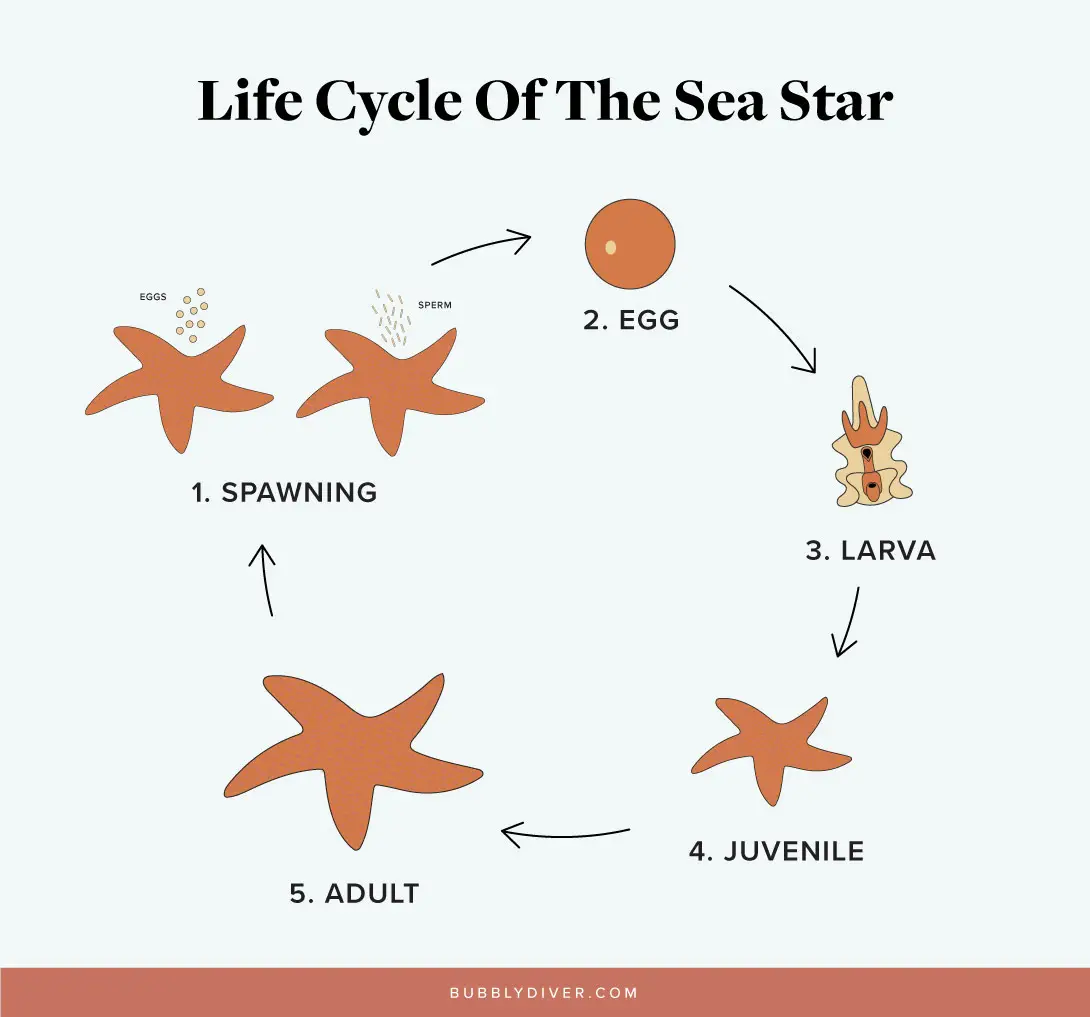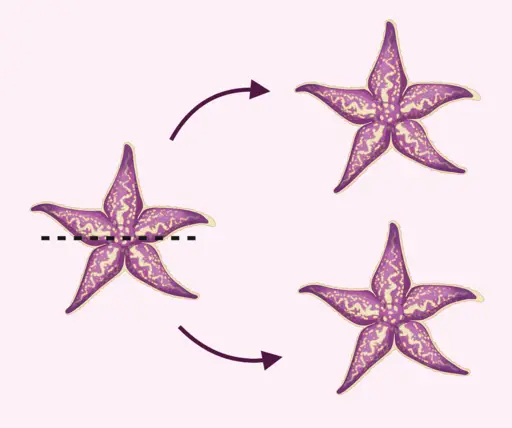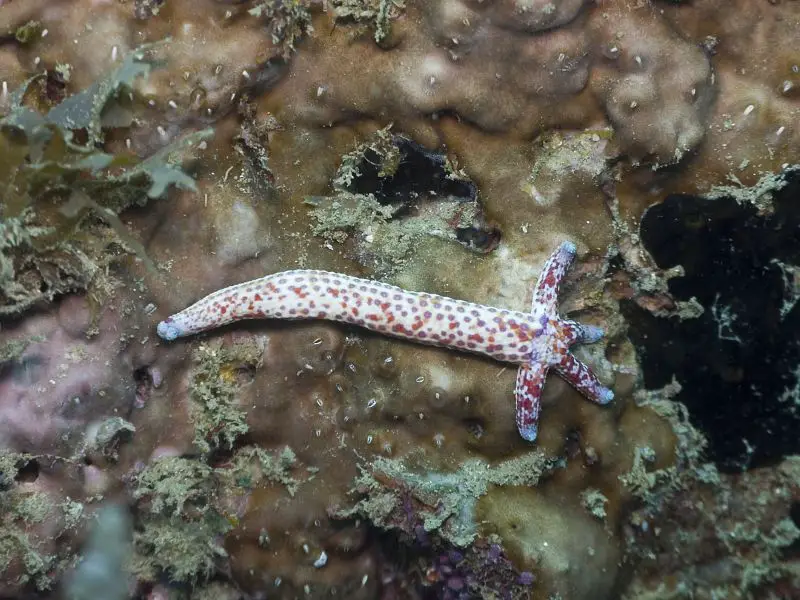How Are Starfish Born?
Starfish, or sea stars, are fascinating marine invertebrates with unique lifestyles and unique ways of reproducing. Have you ever wondered how starfish are born? In this post, we’ll talk all about that. However, let’s start with a quick answer:
Starfish can reproduce in a few ways: sexually (most common) by releasing eggs and sperm into the water where they fertilize, asexually by dividing their bodies, and some sea stars brood their eggs under or inside their bodies.
However, this certainly doesn’t tell the whole story, and in this post, I’ll explain more about how starfish are born and their development process. Read on!
Starfish sexual reproduction (spawning)
Sexual reproduction is the most common way of starfish reproduction. We can divide this process into five stages: spawning, egg, larvae, juvenile, and adult.

Spawning
Spawning is the common process of releasing the eggs and sperm for all echinoderms, including starfish. During this process, several females release their eggs, and several males release their sperm into the water column, all at the same time.
Starfish sexual organs, called gonads, are located in each arm. During the spawning, the male gonads fill with sperm, and female gonads fill with eggs. Next, they release them through the opening called gonopore.
Most starfish come together during reproduction, and billions of gametes (reproductive cells) are spewed into the water. This increases the likelihood that eggs will be successfully fertilized and won’t be eaten immediately by predators at the bottom of the ocean.
Most sea stars reproduce in a discrete and predictable annual cycle, but many complex environmental factors control their reproduction, such as water temperature, light, or the phase of the moon.
Interestingly, the amount of eggs starfish produce can vary depending on the size and species of the sea star. For example, the crown-of-thorns seastar releases millions of small eggs and vast quantities of sperm into the water. However, the smallest starfish produce only a few eggs.
Egg
Once free-floating eggs and sperm are successfully fertilized, the eggs wrap around the zygote (fertilized egg). Successive cell divisions divide the zygote into smaller and more numerous cells forming two, four, and eight-cell embryos.
The following stages of egg development are blastula and gastrula, which begin to take on the appearance of a ball. Watch thenimation below to see the starfish development from egg to adult.
Larva
The next stage of starfish development is the larval stage. The egg develops into a bilaterally symmetrical (the left and right halves resemble each other) larva called bipinnaria. The bipinnaria is a free-swimming and feeding larva covered by hair-like organelles.
It starts growing arms with the ciliated bands extending into them and developing an anus. These larvae eat suspended food particles and float for about a few days or weeks before transforming to the next larval stage, called brachiolaria.
Brachiolaria is also a feeding larva, and it grows three short, additional arms. It uses arms to test the substratum and provide an initial, temporary grip during settlement. Once it sinks to the bottom and attaches itself, it starts to metamorphose into the adult form.
Interestingly, some species of starfish develop directly into miniature starfish without an intervening larval stage. Some produce different larvae types, such as yolky nonfeeding brachiolaria, barrel-shaped larva, or yolky nonbrachiolaria larva. These are mostly brooding species that we’ll discuss later.
Juvenile
After the larva settles in suitable habitat and begins metamorphosis. During this process, its body develops into a radial symmetry and starts looking like a miniature sea star. Next, it forms the rest of the organs like the water vascular system, mouth, tube feet, eyes, etc.
The juvenile starfish grows very slowly for the next months, mostly hiding under rocks, far from predators. It feeds on suspended food particles and algae. After a few years, sea stars reach sexual maturity and begin spawning. Interestingly, 30% of a star’s body weight is reproductive material when preparing to spawn.
Adult
Starfish reach their adult stage once they’re about two years old and ready to reproduce. Adult sea stars can grow to a diameter even of 40 inches (1 m). However, their size depends on the species, and some can grow only to about 1/2 inch (1.3 cm) like a paddle-spined sea star which is the smallest species.
Most sea star species have five arms, but many have more. For example, the larger species, the sunflower sea star, can grow up to 24 arms. There are about 2,000 species of sea stars that have different sizes and adapted to different environments. You can find them nearly worldwide, primarily in tropical coastal regions.
Adult starfish do all the “starfish activities” such as eating, breathing, reproducing, hiding from predators, and moving around the seafloor. Read more about it in my other blog post: “What Do Starfish Do?”.
When it comes to the lifespan of the starfish, it isn’t easy to establish it on average because of the species diversity. Additionally, starfish don’t have characteristic features determining their age. Some studies estimated that starfish could live 35 years on average, and you can read more about it in my other blog post: “How Long Do Starfish Live?”.
Starfish sexual reproduction (brooding eggs)
There are some starfish species that brood eggs by either enveloping or holding them in specialized structures. These creatures have male and female genitals in one body and can fertilize their own eggs. You can read more about it in my other article: “Do Starfish Lay Eggs?”
For example, the fived-armed cushion star (Parvulastra exigua) deposits eggs in sticky masses on rocks of coastal reefs and tide pools. In this case, baby starfish complete their development on their own.
Other species care for their young throughout their whole development, such as Anasterias sea star that holds its eggs around its mouth, located underside of its body, while they develop. Other species, like Smilasterias multipara, incubate their eggs in their stomach and don’t feed themselves until approximately a month later, when the young disappear.
Starfish asexual reproduction
One of the reasons for starfish’s long lifespan is that they can regrow their lost arms! This unique availability is called asexual reproduction. This form of reproduction is less common for echinoderms and only about 80 species are known to be able to reproduce by this method, including about 24 species of starfish.
Starfish species can reproduce asexually in two ways: by body fission or by autotomy of one or more of their arms.
Fission
Fission occurs when the animal splits its body into two parts and each half regenerates into a new and complete individual. The division takes place either across the sea stars’ central disc or at the base of the arm.

During this process, the individuals break up the internal organs of the disc such as jaws, stomach, nervous system, etc. Afterward, they need to close the wide wound, regenerate the organs, and grow new arms. The regeneration rate may vary depending on species, their size, food availability, and other conditions, but generally, the regeneration of the whole body can take about a few months.
Fission often occurs during a specific period of the year. Sea stars regenerate the new disc and arms during the rest of the year until the individuals are practically symmetrical and fission occurs again. Fission can also associate with some stress factors such as low tides during which starfish may be exposed to the air.
Autonomy
Autotomy occurs when starfish shed an arm with part of the central disc attached. The detached arm continues to live independently as a “comet” and eventually grows into a new individual. Examples of species that do that frequently are Linckia multifora and Linckia guildingi.

The study in Hawaii found that the detachment of an arm isn’t a sudden event, but most fractures take place about 1 inch (2.5 cm) from the disk. It starts with a small crack on the lower surface of the arm and spreads towards the upper side of the starfish.
Next, the animal’s tube feet work together and pull two parts apart in opposite directions. The whole process takes about an hour to complete, and the damaged tissue heals in about ten days. The animal grows an arm back for several months.
Interestingly, almost all sea stars can regenerate their limbs, but only a few sea star species can reproduce in these ways. The reason for this behavior is not entirely known, but it could be a response to predators.
What’s more, asexual reproduction is common for species that live in harsh conditions to make spawning successful or don’t produce many eggs.
Resources
- Larry R McEdward and Benjamin G Miner. Larval and life-cycle patterns in echinoderms. Canadian Journal of Zoology. 79(7): 1125-1170. https://doi.org/10.1139/z00-218
- In Byrne, M., In O’Hara, T. D., CSIRO (Australia),, & Australian Biological Resources Study,. (2017). Australian echinoderms: Biology, ecology and evolution.
- Image: HDRB, CC BY-SA 4.0 https://creativecommons.org/licenses/by-sa/4.0, via Wikimedia Commons
You may also like:

Welcome to Bubbly Diver!
I’m glad to see you here. This blog is created for all marine creature lovers by a bubbly diver - me, Dori :)


